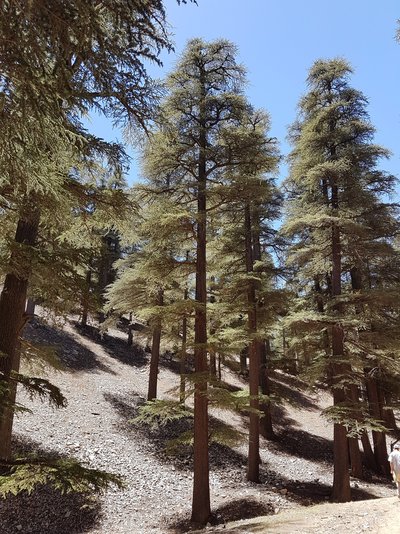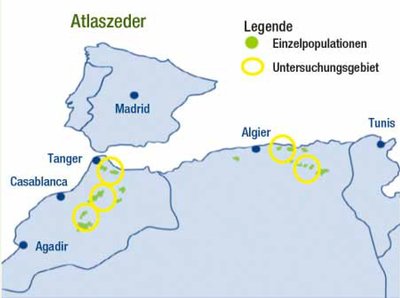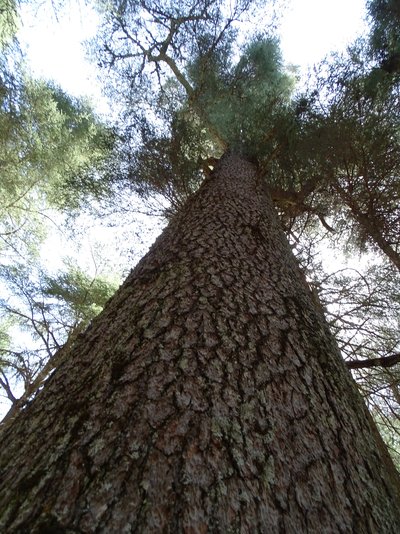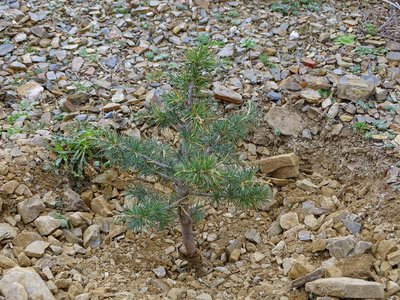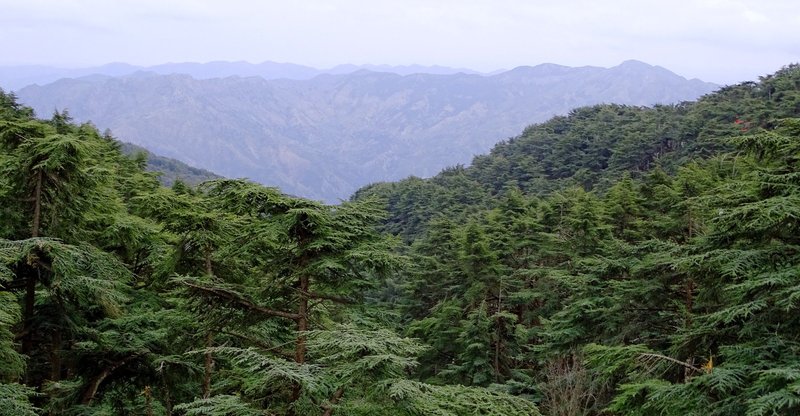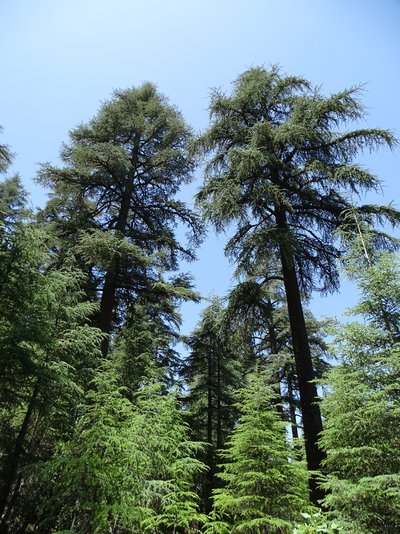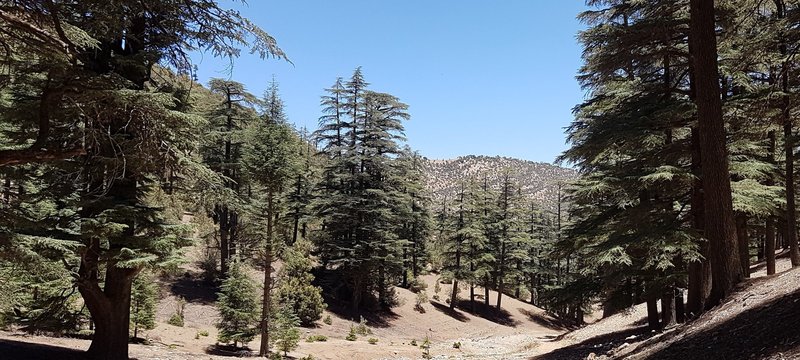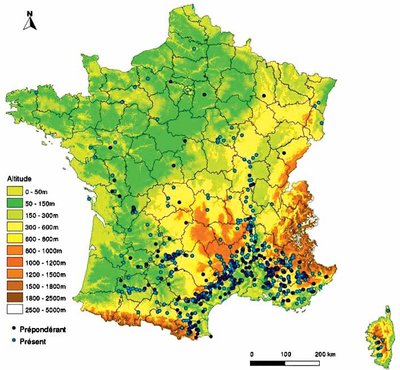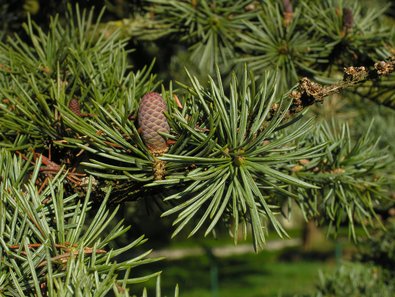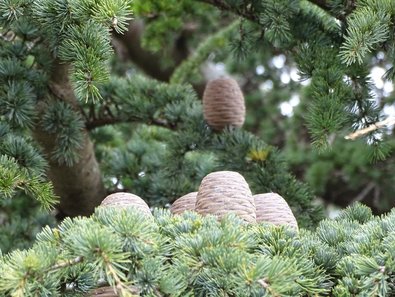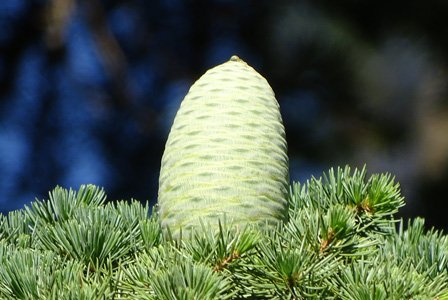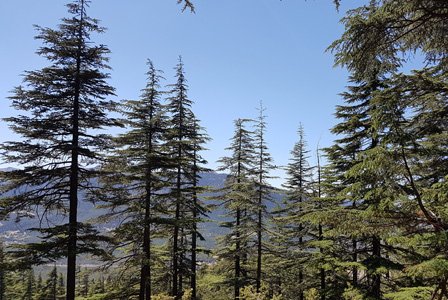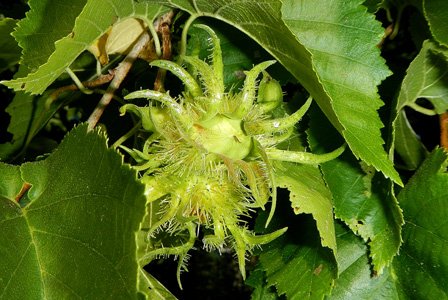In order to create a scientific basis for the evaluation of possible replacement tree species, the “CorCed” project, funded by the [German] Federal Ministry of Food and Agriculture (BMEL), was launched in October 2015 to investigate the viability and suitability of provenances of Atlas cedar (Cedrus atlantica), Lebanon cedar (Cedrus libani) and Turkish hazel (Corylus colurna) for cultivation in Germany.
All three tree species studied in the project show characteristics which are increasingly important in the face of climate change, such as drought-tolerance, frost-tolerance, and an ability to integrate easily in forest communities, among others.
Provenance trials are to be carried out in order to identify provenances of cedar suitable for cultivation in Germany. The first step was to visit and carry out a professional evaluation (phenotypic and genetic analysis) of stands of possible alternative tree species, so that provenance recommendations can be made, and so that it is clear, when the recommendation is made, where the desired reproductive material can be obtained. The systematic establishment of provenance trials plays a key role in the evaluation of the individual provenances. The trials should cover different environmental conditions.
Climate change is happening too fast for local populations to be expected to adapt naturally. From a genetic point of view, adaptation takes place over several generations. In order for the new tree species to be able to adapt to the new, changing environmental conditions and contribute to the stabilisation of unstable stands, they should have a high genetic diversity. The possibilities of forest genetics should be used to exclude the use of populations that are genetically limited. The forest owner cannot tell from the seed whether this material that will later produce several thousand plants has this genetic diversity. The genetic make-up of these trees, which plays a crucial role in their adaptability, growth and quality, is not known and carries a high risk.
Distribution area of the Atlas cedar
The natural distribution area of the Atlas cedar is limited to the North African mountainous regions of Morocco and Algeria. In Morocco, these are the Rif, Middle Atlas and High Atlas regions. In the Middle Atlas, our Moroccan colleagues distinguish between provenances from the Orient (from the Latin Oriens, meaning “East”) and Occident (Latin Occidens, meaning “West”).
The forest area on which Atlas cedar occurs currently covers around 140,000 ha. Some of these sites are badly degraded. The Atlas cedar occurs in the Mediterranean sub-humid altitudinal zone of the continental Middle and High Atlas (700 to 1,000 m). The Atlas cedar is at its best on the plateaus of the Middle Atlas mountain range, at altitudes of 1,600 to 2,200 metres above sea level. The precipitation there is relatively high at 900 to 1,500 mm. From the Middle Atlas (Azrou) eastwards, the cedar populations dwindle more and more, and only the highest mountains with the highest levels of precipitation are colonised.
In Algeria, there are populations in the Tell Atlas and the Sahara Atlas mountains. Here it is the Mediterranean semi-arid altitudinal zone with annual precipitation of 500 to 700 mm (Sahara Atlas) that is colonised. Provenances from the Sahara Atlas are considered to be particularly drought-tolerant. Because of its valuable timber, the Atlas cedar has been heavily overexploited in Algeria and now only remains on an area of around 14,000 ha.
In Europe, the Atlas cedar was introduced in the first half of the 19th century as an ornamental and park tree. These park trees are mostly free-standing, and should not be included in assessments of vigour and trunk form, as the species has a much higher potential on forest sites. In France, the Atlas cedar has been used for the reforestation of devastated and erosion-prone areas since the middle of the 19th century. The seed used was characterised by its high level of genetic diversity. The Atlas cedar has shown itself to be able to adapt to the difficult site conditions here. The propagation material used is of Algerian origin and from the Tell Atlas Mountains.
The Atlas cedar is of increasing importance in timber production, and is being cultivated on around 20,000 ha. In provenance trials, the growth of different populations of Atlas and Lebanon cedars has been tested. The knowledge gained from these trials is very useful, but it cannot be fully applied to Germany because of the different climatic conditions.
The Atlas cedar occurs on calcareous and siliceous soils. For its optimum growth, siliceous soils are more suitable. It tolerates carbonate soils only if they are deep and there is sufficient rainfall.
It tolerates temperatures from -28 °C up to +40 °C, but not periods of cold that last too long. The Mediterranean climate is characterised by a pronounced dry period in summer. The distribution of the Atlas cedar extends over several altitudinal zones with varying amounts of precipitation (min. 600 mm required annually, optimally 900 mm), which falls mainly in the winter months.
Visits to potential harvesting sites
To be able to provide important information on this tree species as quickly as possible, a genetic characterisation and a phenotypic assessment of the potential populations in the natural range of the respective tree species was to be carried out.
Algeria
After long and intensive efforts, the Bavarian Forest Genetics Office (AWG) was able to establish contacts with the Forestry Directorate (GDF) and the National Forestry Research Institute (INRF) in Algeria in order to carry out a first field visit. The German society for international cooperation GIZ (Gesellschaft für internationale Zusammenarbeit), which operates a branch office in Algiers, was of great assistance in this. It is planned in the project to select four provenances from Algeria for the planned provenance trial, in order to cover the different ecological growing conditions and possible genetic adaptations.
On the first trip, a visit was made to a potential seed crop stand in the Tell Atlas mountain range near the Algerian town of Blida (about 80 km south of Algiers). This cedar stand is in the 1,500 ha Chréa National Park. It meets all important requirements for harvesting and as a long-term seed supply. The area of occurrence of the Atlas cedar in Chréa is largely contiguous and extends from an altitude of 800 m to 1,500 m a.s.l.. The biggest problem here continues to be the high pressure from grazing, which is leading to the senescence of the population. However, dense areas of forest corresponding to images of central European forests were also observed, clearly demonstrating the growth potential of the Atlas cedar.
We also visited a tree nursery near Blida. This produces 14,000 cedar seedlings annually. All plants produced are planted in the Blida forestry office district. This is a major contribution to the conservation of this tree species, which was added to the list of endangered tree species in 2013. With our colleagues from the [Algerian] National Forestry Research Institute, we discussed topics such as seed testing, genetic characterisation and the cultivation of high quality planting material. Biennial plants were planted. The Atlas cedar shows a higher tolerance of dry periods and is considered to be more drought-resistant and cold-resistant than other Mediterranean tree species, although seedlings in the first year of growth are at high risk in dry conditions.
Morocco
Following the successful establishment of contacts with the Moroccan forestry administration in Rabat, visits were made to selected seed crop stands of Atlas cedar in the Middle and High Atlas Mountains as well as in the Northern Reef Mountains of Morocco. The forestry administration has identified several seed crop stands of Atlas cedar in cooperation with the German Society for International Cooperation GIZ. These are regularly harvested to produce suitable planting material for the reforestation of devastated areas.
According to the estimation of our Moroccan colleagues, there are still around 140,000 ha of cedar forest in Morocco. Most of this forest has been placed under protection by the Moroccan forestry administration. Along with climate change, which is already having a greater impact here than in Central Europe, grazing is the biggest problem here too for the long-term conservation of the cedar forests. In the mountain regions, livestock farming (sheep and goats) is still an important livelihood. In the Rif Mountains, the regeneration in the cedar stands is good, as there is not so much grazing there.
One of the largest contiguous cedar areas is in the Mediterranean montane region of the Middle Atlas mountain range. It is sub-divided into eastern and western areas, where the seed obtained is also used. The cedar population in the east is at particular risk from climate change. In the seed crop stand we visited, the Atlas cedar grows on basalt. Several generations of trees can be found here, with some individual trees older than 600 years. Some massive and branch-free individual trunks are to be found, depending on the availability of light. All the older trees are of impressive dimensions. The seed-harvesting stands in Morocco are used for forestry purposes, mostly on a single-tree basis. This stand is one of the most important seed crop stocks and has to date provided a large part of the seed supply in the Middle Atlas mountains.
The seed crop stand we visited in the High Atlas Mountains (near Midelt) stands at 2,000 m above sea level and is characterised by very vigorous individual trees with straight trunks. The massive Atlas cedars, often with knot-free lower trunks, reach heights of 25 to 30 m here, in some cases even up to 40 m. The average annual precipitation is extremely low, amounting to around 450 mm. Most of the precipitation falls as snow in winter, in some years as early as November, and can lie until April. The average monthly temperature drops to -5°C in January. Nevertheless, the annual average temperature is well over 12 °C. Larger quantities of seed can be harvested here regularly. These are absolutely necessary for the production of planting material and afforestation of the small isolated stands. The cedars retreat to the tops of the basalt cones and can only survive at altitudes above 1,600 m and on northern slopes. No younger atlas cedars or natural regeneration were found on south-facing slopes. Here, tree species such as Quercus rotundifolia (holm oak, synonym Q. ilex sub. rotundifolia) and juniper species such as Juniperus oxycedrus (prickly or cade juniper) and Juniperus thurifera (Spanish or incense juniper) are to be found. Some of the Moroccan provenances of Atlas cedar are very interesting from the forestry point of view as a result of their good shape and growth characteristics. They should be included wherever possible in provenance trials with this tree species.
France
The Atlas cedar was introduced in France in 1862, and used for the reforestation of devastated sites at risk of erosion. Because of the high genetic diversity of the material used, the Atlas cedar has managed to adapt to this location. All three of the initial stands (Mont Ventoux, Menerbes and Saumon) are approved for seed harvesting. Seed of the highest category, “Tested”, is obtained from these seed crops and brought to market. It is the only seed available on the market.
We visited two of the three main Atlas cedar sites in France with our French colleagues from the National Institute for Agricultural Research (INRA) in Avignon. Our colleague Dr. Francois Courbet presented the French concept for the Atlas cedar and the different types of trials (e.g. provenance trials, cultivation trials and growing space trials) and pointed out the many years of experience with this tree species. The growing space trial gave an impressive demonstration of the effects that different growing spaces can have. The aim must be to apply this experience already gained to cultivation in Germany, and to gain further scientific insights in cooperation with our French colleagues.
Following this visit, a visit to the seed crop stand at Mont Ventoux (700 m a. s.l.) was made. The detailed documentation here of the progress of the stands from the initial import of the seed until today is particularly important. Here we are already seeing the third generation of Atlas cedar through natural regeneration. The trees have developed good trunk shapes and can be used as a seed source without reservation. According to our French colleagues, the Atlas cedar is not a pioneer tree species. It only colonises open landscapes very slowly. After the visits to the different experimental plots and the collection of samples for genetic characterisation, the cooperation on genetic monitoring and on the conservation and breeding of the tree species were discussed.
Funding for this joint project is provided by the Federal Ministry of Food and Agriculture (BMEL). The project sponsor for the BMEL for the “Renewable Resources” funding programme is the Agency for Renewable Resources (“Fachagentur Nachwachsende Rohstoffe e. V.”) (FNR).

